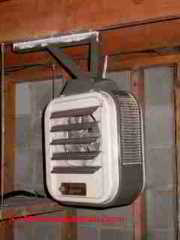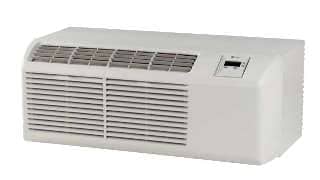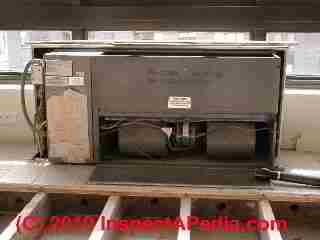 Fan Convectors, Fan Coil Heaters, Water-to-Air,
Fan Convectors, Fan Coil Heaters, Water-to-Air,
Inspection, Repair, Maintenance
- POST a QUESTION or COMMENT about heating convectors and water to air fan convector heating units, problem diagnosis & repair
Fan-convector heating systems types, installation, troubleshooting, thermostats & controls :
Here we explain the identification, selection, diagnosis and repair of hydronic or steam heated convector fan heaters and similar water-to-air or steam-to-air heating devices such as ceiling, wall or floor mounted heating convectors and heating coils in heat pump air handlers and ductwork.
This article focuses on heating convectors heated by hot water from a heating boiler or heat pump. Hydronic heating convectors use hot water or steam from a separate boiler to heat a water-to-air heat exchanger coil mounted in the heating convector unit. A thermostat or manual switch operates a fan to blow room air across the heat exchanger coil to deliver heat where it is wanted.
Our photo above (at page top) shows a hydronic (hot water) heated wall-mounted fan convector heater in a New York City apartment. You can see dual blower fans at the bottom of the unit (the air intake port); Hot water piping from the building boiler is visible at the left edge of this convector heater.
InspectAPedia tolerates no conflicts of interest. We have no relationship with advertisers, products, or services discussed at this website.
- Daniel Friedman, Publisher/Editor/Author - See WHO ARE WE?
How Ceiling, Wall, or Floor Fan Convector Units or Hydronic Heating Coils Convert Hot Water Heat to Warm Air Heat
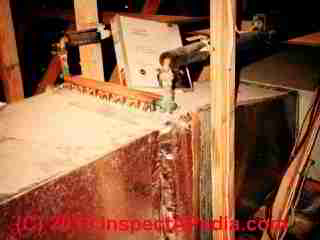 Fan convector heaters combine a heat source such as hot water piped through a heat exchanger coil and a fan to blow warm air into HVAC ductwork of a warm air heating system or to push warm air into a chilly spot such as a basement, crawl space or into a bathroom or kitchen where there may not be wall space for a conventional heating register radiator.
Fan convector heaters combine a heat source such as hot water piped through a heat exchanger coil and a fan to blow warm air into HVAC ductwork of a warm air heating system or to push warm air into a chilly spot such as a basement, crawl space or into a bathroom or kitchen where there may not be wall space for a conventional heating register radiator.
Fan Convector Heaters as Backup Heat for Heat Pumps
Fan convector heater units as a main building heat source or as a back up heat source where a heat pump is installed (combining air conditioning and heating).
As our photo of a hydronic heating coil (photo at left) shows, hot water heated by a hydronic heating boiler is used to warm air via a heat exchanger that is mounted in an air handler.
Pipes conduct hot water from the boiler to the heat exchanger and back to the boiler. The air handler blows building air from return registers and ducts into the air handler, across the heating coil, and on to supply ducts and registers.
We illustrate and discuss conventional heating convectors (units that work by "gravity" or warm air convection without the added output of an internal fan) at RADIATORS.
Fan Convector Heaters as Add-On Heat for Crawl Spaces, Basements, Garages
Used in crawl spaces, garages, basements, or other locations where additional heat is required or where we want to add heat to a previously un-heated area, ceiling, wall, or floor mounted fan convector heating units are a convenient way to push warm air heat into a chilly or un-heated area by converting hot water heat produced by a heating boiler to warm air heat provided by a fan convector unit.
Fan Convector Heaters as Add-On Heat for Freeze Protection in buildings
We often find an electric or hot water-heated convector unit mounted in crawl spaces or other building areas in freezing climates as a step to protect building plumbing from freeze-ups.
Notice that the convector heater suspended from the crawl space ceiling (photo at left) has nothing combustible too close to the heater? Make sure that your added heat source does not create a fire risk
This is an electric ceiling mounted fan convector unit.
Similar fan convector heaters obtain their heat from hot water piped as a separate heating zone or as a loop off of an existing heating zone that is otherwise heated by a conventional hot water heating boiler or hydronic heating system fueled by heating oil, gas, a heat pump, or even solar heating.
You can see an example of a ceiling mounted fan convector used to avoid freezing pipes in a crawl area at Heat tapes, Heat, Insulation prevent Freeze-Up.
Reader Question: standard temperature ranges for heating water at the boiler, at the baseboard or at the convector heater unit of a PTAC (Packaged Terminal Air Conditioning / Heating Unit)
[Click to enlarge any image] Above: A Trane packagted terminal air conditioner & heat pump unit model PTEE or PTHE, cited below.
2016/02/14 Rich said:
I own a condominium unit in a 7 story building in NYC. The heat is provided by a PTAC unit with a heat convector below the unit and a fan in the PTAC that draws air through the convector and blows the warm air through the vent at the top of the PTAC unit.
I've owned the unit for 15 years and, until recently, the heat dispersed by the convector was always sufficient to heat the unit without the blower, unless temperatures were below 20 degrees. Then we would have to turn on the blower.
The last two years, it seems building management has lowered the water temperature of the hot water that flows through the system and the convector is never hot to the touch. It is only warm.
I had the super test the temperature of the pipe feeding hot water to the unit and the temperature of the metal side of the unit. The temperature of the pipe was 137 degrees and the unit was 106 degrees. I'd like to know if there is a standard temperature, or temperature range, of the water entering the unit and a standard temperature, or temperature range, of the convector surface.
Reply:
Interesting question, Rich. I don't know an authoritative answer but here is some data along with some arm-waving.
There are some conflicting objectives in building heat management - I don't think the problem is peculiar to PTAC units (Packaged terminal air conditioning / heating).
1. Lower boiler temperature to save heating cost?
The super lowers the boiler temperature thinking that they are saving on heating cost. And indeed there are some (more sophisticated) heating controls that adjust the boiler set temperature as outdoor temperatures vary, using lower temperatures when the outdoor temperature is higher.
I know there are claimed heating savings but I mistrust them a bit as I'll explain. I will agree that it wastes energy to overheat a room in response to a call for heat, particularly if there is one thermostat controlling heat in multiple rooms whose individual rate of heat loss will vary.
2. Higher boiler temperatures give faster & more efficient heat transfer into the occupied space
Because the thermal conductivity of water is exponentially greater at higher temperatures, we actually get more efficient heat transfer from the heating convector into the room air when the temperature difference between the convector water and the room air is greatest. Or re-stating, we get not only faster but more efficient transfer of heat out of the boiler water, through the finned copper tubing into the room air when the boiler water is hotter.
3. Get objective heating data by measuring actual water temperatures
Because heating baseboard runs vary in length, diameter, and in radiating device designs (some convectors or baseboards are designed to output far more heat per linear foot of radiating device than others), and because heating water velocity (typically 4 gpm) is also variable depending on system design and controls, I can't predict what the water temperature will be at a specific point in a hot water heating piping loop for an unknown building.
Some HVAC engineers might make a stab at it but IMO for an installed system instead of arm-waving we should just measure temperatures - as you have done.
You may want also to measure the water temperature at the INLET end of the heating convector as well as at the OUTLET end. That will give us some important data about the heat transfer rate.
With that data and specs on the convector heater, along with air temperature and air speed, one could predict what the heating capacity of the convector is.
You can see how challenging this becomes when we want true objective data. Because variations in outdoor temperature as well as variations in the heat loss rate for a given heated building or apartment or room all must be considered in making a statement about the required input BTUh to give adequate heat.
4. Recommended boiler operating temperatures
With all of the apology above, I prefer to run a boiler as hot as possible - close to 200F.
See BOILER PRESSURE & TEMPERATURE SETTINGS
5. Hot water heat design temperatures & BTU output rates:
Typically the heating system is designed so that by the end of the heating loop the temperature drop will be about 20 deg. F. between the temperature of water leaving the boiler to the temperature of water at the end of the heating loop.
I guesstimate that in a tall building with many occupying units, if you go to the most-distant point in the heating water loop - where the temperature would be expected to be at its lowest, you will probably find that if the water is under 150 °F the heat output is going to be rather modest. Or from some sources, a linear foot of baseboard (that's less than at a convector) will output about 600 btuh at 180 °F and a flow rate of 4 gpm.
The specs for your convector will be different (ask the manufacturer). But using typical 3/4" finned copper baseboard tubing, at 4 gpm flow, at 200 °F we get about 750 BTUh per foot, dropping to 340 BTUh at 140 °F. Here are some more example numbers courtesy of Slant/Fin:
Rated Heat Output for Finned Copper Baseboard in Residential Installations |
||||||||||||
| Heater Element Type | Water Flow Rate GPM | Pressure Drop1 | BTUs / Hour / Linear Foot at 65 °F entering air2 | |||||||||
| 110°F4 | 120°F4 | 130°F4 | 140°F | 150°F | 160°F | 170°F | 180°F | 190°F | 200°F3 | |||
| NO. 30-75 Baseboard with 3/4" E-75 element |
1 gpm | 47 | 160 | 210 | 260 | 320 | 380 | 450 | 510 | 580 | 640 | 710 |
| gpm4 | 525 | 170 | 220 | 270 | 340 | 400 | 480 | 540 | 610 | 680 | 750 | |
Notes to the table above
Notes:
Source: Slant/Fin see citation given below.
1. Pressure drop given in milli-inches per foot.
2. Ratings at 140°F determined by multiplying 150°F rating by the I=B=R conversion multiplier of .84.
Ratings are for element installed with damper open, with expansion cradles. Ratings are based on active finned length (5" to 6" less than overall length)
and include 15% heating effect factor. Use 4 gpm ratings only when flow is known to be equal to or greater than 4 gpm; otherwise, 1 gpm ratings must be used
3. The original source gives added data up to 220°F
4. The three lowest temperatures, 110°F, 120°F 130°F are ratings given for condensing boilers.
If the temperature drops from 200 °F at the boiler to 140 °F at the input to your convector, the heat output at that convector is cut in half.
The heated space will need enough convector capacity (or for baseboards, linear feet of baseboard) to provide enough BTUh to handle the room's heat loss on the coldest days of the year.
6. Recommended input water temperatures for PTAC units
Using as an example Trane PTAC units such as the Trane PTAC shown installed above (source cited below), the BTUh heating capacity ranges (depending on model and number of heaters employed) between 5,800 BTUh and 15,000 BTUh. The heat output varies by water flow rate, system pressure drop, and the fan speed. But only two water temperatures were cited by Trane for these PTAC Units
- 200 °F entering water temperature
- 180 °F entering water temperature
PTAC Unit Heating Capacity using Hot Water using Trane PTAC unit data |
||||||||||||||
| 7000 & 9000 Btuh PTAC Units | 12000 Btuh PTAC Units | 15000 Btuh PTAC Units | ||||||||||||
| GPM | Pressure Drop (psig) | 200 °F EWT1 | 180 °F EWT | 200 °F EWT1 | 180 °F EWT | 200 °F EWT1 | 180 °F EWT | |||||||
| Fan Speed | Fan Speed | Fan Speed | Fan Speed | Fan Speed | Fan Speed | |||||||||
| Coil | 2-way valve | Hi | Lo | Hi | Lo | Hi | Lo | Hi | Lo | Hi | Lo | Hi | Lo | |
| 1.00 | 0.93 | 0.16 | 14.9 | 13.4 | 12.6 | 11.2 | 16.9 | 14.4 | 14.3 | 12.2 | 17.9 | 15.5 | 15.0 | 13.3 |
| 2.00 | 2.10 | 0.64 | 16.8 | 15.2 | 14.2 | 12.7 | 19.3 | 16.1 | 16.2 | 13.6 | 20.4 | 17.8 | 17.2 | 15.3 |
| 2.75 | 3.85 | 1.21 | 17.2 | 15.5 | 14.6 | 13.0 | 20.0 | 16.6 | 16.8 | 14.0 | 21.1 | 18.1 | 17.7 | 15.5 |
Notes to the table above
Source: Trane, cited below. The data in this table is excerpted from Trane's Table 9, Heating Capacity - water. "Trane Packaged Terminal Air Conditioners & Heat Pumps, Catalog", (March 2007), retrieved 2016/02/14, for PTAC models PTEE and PTHE, PTAC-PRC002-EN, original source: http://www.trane.com/commercial/uploads/pdf/1129/ptac-prc002-en.pdf
The Trane units cited below also are offered in steam heated models for steam pressures between 2 and 5 psig. Depending on steam pressure and fan speed and model, the BTUh output for heating ranges from about 17,800 BTUh to 26,300 BTUh.
Based on ARI Rating Conditions of 70°F Entering Air Temp., 200°F Entering Water Temp and 180°F Leaving Water Temp., Max. Water Temperature 200°F Max. Water Pressure - 200 psi
1. EWT = Entering Water Temperature
Check with the manufacturer of your PTAC units to find the design input water temperatures for your unit by brand and model.
7. Other stuff to check:
Finally - well for now anyway - check that the convector is not dust clogged so we can avoid THAT embarrassment.
Question: what do you call the heating system that pumps hot water to "radiators" inside of a forced air system?
2016/05/29 Pat said:
The house I just put an offer on has a boiler, however, it does not have traditional radiators. It pumps hot water to radiators inside the forced air system. I have never seen a system like this. What isint called and is it efficient? Also, I am planning on doing a renovation to the home and was wondering should I replace the system with a traditional forced air system?
This question was posted originally
Reply: fan coil unit, hydronic coil, fan convector heater properties, efficiency, references
Thanks for the question, Pat. You are describing a water-to-air heating system. Synonyms include "hydronic coil" and "fan convector" or "fan coil unit" heating system. Hot water heated by a heating boiler (a hydronic heating system) is circulated through a finned coil placed in an air handler or in some cases right in an air duct.
Air is blown through the duct (or through the air handler) across the heated coil, thus heating the air as it passes by.
Your system may be a "blow through" (fan pushes air through the heating coil) or a more thermally-efficient "draw through" (fan sucks air thorugh the duct system and through the heating coil).
This approach to heating is often used when a designer wants to use the same duct system for distributing heated air or cooled air; In some designs the use of a a boiler-heated fan coil to warm air can be quite efficient. These systems are also often used as backup heat in a heat pump system.
Take a look at FAN COIL & FAN CONVECTOR HEATERS & HYDRONIC COILS beginning at the top of this page
Water to Air Hydronic Air Heat, Convector & Baseboard Heat Manuals & Guides
- AIR VELOCITY RATES TYPICAL FPM
- Carrier Corp. FAN COILS ACCESSORY ELECTRIC HEATERS WIRING DIAGRAMS [PDF] (2013) CAC / BDP D 7310 W. Morris St. D Indianapolis, IN 46231 USA
- DUNKIRK HYDRONIC AIR HANDLER for BOILER INSTALLATION MANUAL Series HWFC [PDF] (2000), retrieved 2018/01/27, original source: http://www.dunkirk.com/sites/default/files/410_0.pdf
- HONEYWELL TB7100A1000 MultiPRO MULTISPEED MULTIPURPOSE THERMOSTAT [PDF] (2011) Honeywell Controls, Honeywell International Inc. 1985 Douglas Drive North Golden Valley, MN 55422 customer.honeywell.com - Honeywell Limited-Honeywell Limitée 35 Dynamic Drive Toronto, Ontario M1V 4Z9 Canada
- Honeywell T6380 Series ELECTRONIC FAN COIL THERMOSTAT MANUAL [PDF] (1998) Op. Cit.
- HONEYWELL TB6575/TB8575 SuitePro DIGITAL FAN COIL THERMOSTATS PRODUCT SPECIFICATIONS [PDF] (2008)
- HONEYWELL TB6575/TB8575 SuitePro DIGITAL FAN COIL THERMOSTATS INSTRUCTIONS [PDF] (2013)
- Honeywell T6169 FAN COIL THERMOSTAT INSTRUCTIONS [PDF] (2001)
- International Comfort Products, FVM4X"B" SERIES FAN COIL UNIT INSTALLATION INSTRUCTIONS [PDF] International Comfort Products, Lewisburg TN 37091 USA
- International Comfort Products, WIRING DIAGRAM MANUAL Horizontal Fan Coil FMC4, FMU4, WAMC, WATC [PDF] International Comfort Products, Lewisburg TN 37091 USA
- MARITIME GEOTHERMAL LTD AHW_SERIES HYDRONIC AIR HANDLER (Fan Coil Unit) MANUAL [PDF] (2015) Maritime Geothermal Limited, PO Box 2555, Petitcodiac NB E4Z 6H4 Canada, Tel: 506-756-8135, Email: info@nordicghp.com Web: www.nordicghp.com
- "Slant/Fin Ratings Chart - Residential Baseboard, Fine/Line 30", (2007) retrieved 2016/02/14, original source: SLANT/FIN CORPORATION, Greenvale, NY 11548, Tel: (516) 484-2600, FAX: (516) 484-5921 Canada: Slant/Fin LTD/LTEE, Mississauga, Ontario www.slantfin.com
- SuperiorRex RAV VERTICAL FAN COIL UNIT INSTALLATION MANUAL [PDF] Superior Rex, 605 Shiloh Rd Plano TX 75074 USA Website: www.superiorrex.com Tel: (972) 212-4830
- Trane Packaged Terminal Air Conditioners & Heat Pumps, Catalog [PDF] (March 2007), retrieved 2016/02/14, for PTAC models PTEE and PTHE, PTAC-PRC002-EN, original source: http://www.trane.com/commercial/uploads/pdf/1129/ptac-prc002-en.pdf
- Titus, FAN COIL UNIT INSTALLATION MANUAL THH-Horizotal Units [PDF] Titus HVAC, 605 Shiloh Rd., Plano TX 75074 USA website: www.titus-hvac.com
- Also seeReferences or Citations
...
Reader Comments, Questions & Answers About The Article Above
Below you will find questions and answers previously posted on this page at its page bottom reader comment box.
Reader Q&A - also see RECOMMENDED ARTICLES & FAQs
On 2020-11-13 by (mod) - buy a digital thermostat to replace the analog thermostat for a 120V water-to-air fan convector
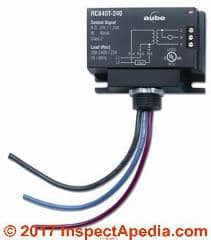 Rodney,
Rodney,
A bit of good news is there's no construction or mechanical systems problem we will encounter that no one has ever run into before. That means there's almost always a solution.
In this case you want a relay that is wired between the new thermostat that you want to use and the line voltage controls for the fan heater.
The thermostat switch is the relay and the relay switch is the control.
A nice example is at
CONVERT LINE to LOW VOLTAGE THERMOSTAT
On 2020-11-12 by Rodney
I have an Water-to-Air Heating Fan Convector, it does hot and cold water, and the water temperature is controlled by the building.
The motor has 3 speeds and it looks to run off of wall power (so 110 v or so). I've been trying to find a digital thermostat to replace the super-innacurate analog thermostat, but all I have found are ones that only have a setting for HEAT but not for COLD.
This analog thermostat is mounted on the wall and only controls on/off once the temp is reached in either hot or cold setting (but y'all know what a thermostat is), and the fan speed is in the convector unit.
What company sells a digital thermostat that runs at 110v that will allow me to replace this analog thermostat, or is there one I can wire directly to the convector that could do hot/cold thermostat, or do hot/cold thermostat with can speeds? Or a 24v regular digital thermostat that could be wired into the existing 110v wiring?
On 2018-12-26 by (mod) -
Rodger
Most likely there is air in the hot water heating piping ahead of these units.
Take a look at the options for fixing this starting at AIR-BOUND HEATING SYSTEMS https://inspectapedia.com/heat/Air_Bound_Heating_System.php
On 2018-12-26 by Rodger
Two Hot water recessed convector type fins are not heating, Replaced valves & vents, getting water out but not getting hot? Removed convectors & used compressed air, nothing came out. Still No Heat???
**(Installed new was boiler last year, new owners have no history on what convectors worked or did not work)
IMAGE LOST by older version of Comments code - now fixed. Please re-post the image if you can. Sorry. Mod.
On 2017-12-27 by (mod) -
Thst sounds as if your .aim heater is not working and needs a service call. I think you ate p n backup heat
On 2017-12-27 by Kelly Delerenzo
I've been reading your articles I live in a mobile home it blows air but it's cold but it can be switched to evacuate emergency heat and it blows hot what could be the problems. It's an electric system.help
On 2017-12-20 by (mod) -
Ben
Since the water in a hydronic heating system, including a fan coil system, is usually a closed-system, clogging from mineral deposits isn't usually a problem. Before assuming the coil is clogged I'd look at
- the temperature of the incoming water - if that's too low the coil will indeed cool off quickly and the fan shut will stop
- the circulator to be sure that it's actually moving water (as opposed to water cycling by mere convection)
On 2017-12-20 by Ben Johnson
Hi I work on a site which has a hot water system as a heating system in a school roof, My issue is the coil gets nice and warm and the fan runs for a short period and the coil looses heat really quickly and the fan stops, think it may need flushing but not sure, flow and return stay nice and warm !! Any help would be greatly appreciated
On 2017-07-22 13:20:46.323569 by Paul
For a "hydronic coil" or "water to air" heating system is it necessary to turn off the inlet and outlet valves at the water heater during the cooling season?
On 2016-02-14 23:13:07.657423 by (mod) -
Yes from what I read earlier today, 137 F is below the temperatures at which these units are usually operating (as per the Trane citation).
Let me know what you find, use the page bottom CONTACT link to send along some sharp photos of your PTAC and of any labeling or branding or data tags you can find, and we can comment further.
Thanks for the good question.
On 2016-02-14 by Rich
Thanks for the detailed explanation. I will get some additional temperature readings at input and output. I have very limited knowledge regarding this subject but, if I'm understanding correctly, an input temperature of 137 degrees may be insufficient and should be significantly higher?
On 2016-02-14 by (mod) -
Rich:
for space and to permit citations I've moved your question and a detailed reply into the article above. Keep me posted.
On 2016-02-14 by Rich
I own a condominium unit in a 7 story building in NYC. The heat is provided by a PTAC unit with a heat convector below the unit and a fan in the PTAC that draws air through the convector and blows the warm air through the vent at the top of the PTAC unit. I've owned the unit for 15 years and, until recently, the heat dispersed by the convector was always sufficient to heat the unit without the blower, unless temperatures were below 20 degrees.
Then we would have to turn on the blower. The last two years, it seems building management has lowered the water temperature of the hot water that flows through the system and the convector is never hot to the touch.
It is only warm. I had the super test the temperature of the pipe feeding hot water to the unit and the temperature of the metal side of the unit. The temperature of the pipe was 137 degrees and the unit was 106 degrees.
I'd like to know if there is a standard temperature, or temperature range, of the water entering the unit and a standard temperature, or temperature range, of the convector surface.
Question: cover required on convector type heaters?
(July 22, 2015) William said:
Should these old type convectors be covered or have a surround built around them. How does this affect the operation.
Thanks!
Reply:
William
Yes, the convector assembly normally includes its own cover, typically with an air inlet at its bottom and outlet at its top or upper front.
If someone were to cover the *solid* parts of the convector covering with another material, say for cosmetic reasons, that'd not affect its operation. But if an additional cover were constructed that blocked air inlet or outlet, or that made it difficult to remove the entire cover assembly for service that would be a mistake.
...
Continue reading at WALL CONVECTORS HVAC or select a topic from the closely-related articles below, or see the complete ARTICLE INDEX.
Or see
- AIR VELOCITY RATES TYPICAL FPM
- BLOWER FAN OPERATION & TESTING
- ELECTRIC HEAT - wide variety of electric-heated wall, floor, and kick space fan convector heating units
- THERMOSTAT POWER & VOLTAGE - used to control fan coil heaters & other 120/220/240/250VAC equipment
- WALL CONVECTORS HVAC
Suggested citation for this web page
FAN COIL & FAN CONVECTOR HEATERS & HYDRONIC COILS at InspectApedia.com - online encyclopedia of building & environmental inspection, testing, diagnosis, repair, & problem prevention advice.
Or see this
INDEX to RELATED ARTICLES: ARTICLE INDEX to HEATING SYSTEMS
Or use the SEARCH BOX found below to Ask a Question or Search InspectApedia
Ask a Question or Search InspectApedia
Try the search box just below, or if you prefer, post a question or comment in the Comments box below and we will respond promptly.
Search the InspectApedia website
Note: appearance of your Comment below may be delayed: if your comment contains an image, photograph, web link, or text that looks to the software as if it might be a web link, your posting will appear after it has been approved by a moderator. Apologies for the delay.
Only one image can be added per comment but you can post as many comments, and therefore images, as you like.
You will not receive a notification when a response to your question has been posted.
Please bookmark this page to make it easy for you to check back for our response.
IF above you see "Comment Form is loading comments..." then COMMENT BOX - countable.ca / bawkbox.com IS NOT WORKING.
In any case you are welcome to send an email directly to us at InspectApedia.com at editor@inspectApedia.com
We'll reply to you directly. Please help us help you by noting, in your email, the URL of the InspectApedia page where you wanted to comment.
Citations & References
In addition to any citations in the article above, a full list is available on request.
- "Residential Hydronic (circulating hot water) Heating Systems", Instructional Technologies Institute, Inc., 145 "D" Grassy Plain St., Bethel, CT 06801 800/227-1663 [home inspection training material] 1987
- Boilers, Boiler Conversions, James E. Brumbaugh, ISBN 0-672-23389-4 (v. 1) Volume II, Oil, Gas, and Coal Burners, Controls, Ducts, Piping, Valves, James E. Brumbaugh, ISBN 0-672-23390-7 (v. 2) Volume III, Radiant Heating, Water Heaters, Ventilation, Air Conditioning, Heat Pumps, Air Cleaners, James E. Brumbaugh, ISBN 0-672-23383-5 (v. 3) or ISBN 0-672-23380-0 (set) Special Sales Director, Macmillan Publishing Co., 866 Third Ave., New York, NY 10022. Macmillan Publishing Co., NY
- Installation Guide for Residential Hydronic Heating Systems
- Installation Guide #200, The Hydronics Institute, 35 Russo Place, Berkeley Heights, NJ 07922
- In addition to citations & references found in this article, see the research citations given at the end of the related articles found at our suggested
CONTINUE READING or RECOMMENDED ARTICLES. - Our recommended books about building & mechanical systems design, inspection, problem diagnosis, and repair, and about indoor environment and IAQ testing, diagnosis, and cleanup are at the InspectAPedia Bookstore. Also see our Book Reviews - InspectAPedia.
- In addition to citations & references found in this article, see the research citations given at the end of the related articles found at our suggested
CONTINUE READING or RECOMMENDED ARTICLES.
- Carson, Dunlop & Associates Ltd., 120 Carlton Street Suite 407, Toronto ON M5A 4K2. Tel: (416) 964-9415 1-800-268-7070 Email: info@carsondunlop.com. Alan Carson is a past president of ASHI, the American Society of Home Inspectors.
Thanks to Alan Carson and Bob Dunlop, for permission for InspectAPedia to use text excerpts from The HOME REFERENCE BOOK - the Encyclopedia of Homes and to use illustrations from The ILLUSTRATED HOME .
Carson Dunlop Associates provides extensive home inspection education and report writing material. In gratitude we provide links to tsome Carson Dunlop Associates products and services.


